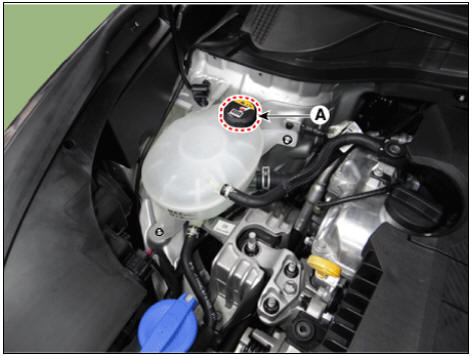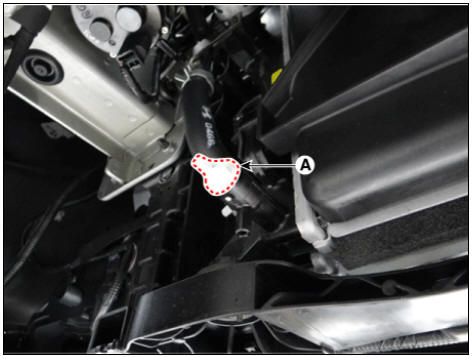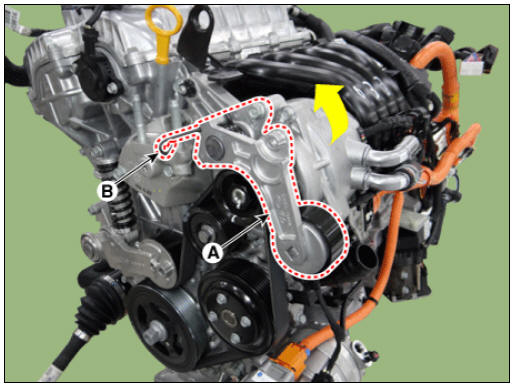KIA Niro: Radiator hoses
Inspection
- Check radiator hoses for the following
(1) Improper attachment
(2) Leaks
(3) Cracks
(4) Damage
(5) Loose connections
(6) Chafing
(7) Deterioration
Coolant level
- Check the coolant level in the coolant reservoir. Make sure it is between the "F" mark and "L" mark.
- If the coolant level in the coolant reservoir is at or below the "L" mark, add coolant to bring it between the "L" and "F" marks, then inspect the cooling system for leaks.
Coolant quality
- Remove the pressure cap.
- Check if there are any excessive deposits of rust or scale around the
radiator cap sub-assembly and radiator
filler hole. Also, the coolant should be free of oil.
If excessively dirty, clean the coolant passage and replace the coolant.
- Install the pressure cap.
Replacement And Air Bleeding
Warning
Never remove the radiator cap when the engine is hot. Serious scalding could be caused by hot fluid under high pressure escaping from the radiator.
Warning
When pouring engine coolant, be sure to shut the relay box lid and not to let coolant spill on the electrical parts or the paint. If any coolant spills, rinse it off immediately.
- Make sure the engine and radiator are cool to the touch.
- Remove the pressure cap (A).

- Remove the engine room under cover.
(Refer to Engine Mechanical System - "Engine Room Under Cover")
- Loosen the drain plug (A), and drain the coolant.

- Tighten the radiator drain plug securely.
- Remove, drain and reinstall the reservoir. Fill the tank halfway to the MAX mark with water, then up to the MAX mark with antifreeze.
- Fill the radiator with water through the radiator cap and tighten the cap.
Warning
To most effectively bleed the air, pour the water slowly and press on the upper / lower radiator hoses.
- Start the engine and allow to come to normal operating temperature. Wait for the cooling fans to turn on several times. Accelerate the engine to aid in purging trapped air. Shut engine off.
- Wait until the engine is cool.
- Repeat steps 1 to 8 until the drained water runs clear.
- Fill fluid mixture of coolant and water (45 - 60%) (except for North America, Europe and China : 45 - 50%) slowly through the radiator cap.
Push the upper / lower hoses of the radiator so as to bleed air easily.
Warning
- Use only genuine antifreeze/coolant.
- For best corrosion protection, the coolant concentration must
be maintained year-round at 45 - 60%
minimum.
Coolant concentrations less than 45 - 60% may not provide sufficient protection against corrosion or freezing.
- Coolant concentrations greater than 60% will impair cooling efficiency and are not recommended.
Warning
- Do not mix different brands of antifreeze/coolants.
- Do not use additional rust inhibitors or antirust products; they may not be compatible with the coolant.
- Start the engine and let coolant to circulate.
- When the cooling fan operates and coolant circulates, refill coolant through the radiator cap.
- Repeat step 11 until the cooling fan operates 3-5 times and bleed air sufficiently out of the cooling system.
- Install the radiator cap and fill the reservoir tank to the "MAX"(or "F") line (A) with coolant.
- Run the vehicle under idle until the cooling fan operates 2 - 3 times.
- Stop the engine and wait for coolant to cool down.
- Repeat 10 to 15 to bleed air out of the cooling system until the coolant level doesn't fall any more.
Warning
As it is to bleed air out of the cooling system and refill coolant when coolant cools down completely, recheck the coolant level in the reservoir tank 2-3 days after replacing coolant.
Coolant capacity : Approx. 5.8 L (1.53 US gal., 6.13 US qt., 5.10 lmp qt.)
Inspection
- Check belt for maintenance and abnormal wear of V-ribbed part. Replace if necessary.
Warning
- Do not bend, twist or turn the drive belt inside out.
- Do not allow the drive belt to come into contact with oil, water and steam.
- Visually check the belt for excessive wear, frayed cords etc.
If any defect has been found, replace the drive belt.
Warning
Cracks on the rib side of a belt are considered acceptable. If the belt has chunks missing from the ribs, it should be replaced.

Removal
- Remove the engine room under cover.
(Refer to Engine and Transaxle Assembly - "Engine Room Under Cover")
- Remove the drive belt.
(1) Using the wrench, turning the mechanical tensioner (A) counterclockwise
and then insert a
stopper pin (B) into the hole.

(2) Install the SST(09244-G2100) to hydraulic tensioner (A) and then compress
the hydraulic
tensioner by tightening the adjusting bolt (B).

Warning
To prevent damage the hydraulic tensioner, slowly must work by using the hand tool.
(3) Remove the drive belt (A).

Installation
- Install the drive belt.
(1) Install the drive belt (A).

(2) Remove the SST (09244-G2100) from the hydraulic tensioner (A) by
loosening the adjusting
bolt (B).

Warning
To prevent damage the hydraulic tensioner, slowly must work by using the hand tool.
(3) Using the wrench, slightly lift the mechanical tensioner (A) and then remove the stopper pin (B).
Slowly place the mechanical tensioner (A).

- Install the engine room under cover.
(Refer to Engine And Transaxle Assembly - "Engine Room Under Cover")
READ NEXT:
 Engine Oil Level
Engine Oil Level
Warning
Be sure that the vehicle is on level ground.
Warm up and stop the engine, and then wait for 5 minutes.
Turn the engine off and wait for a few minutes (about 5 minutes) for the
oil to return to the oil pan.
Pull the dipstick out, w
 On vehicle inspection/ Component Inspection
On vehicle inspection/ Component Inspection
On vehicle inspection
Accelerate the engine to about 3,000 rpm 3 times or more.
Remove the spark plug.
Check the spark plug visually.
If the electrode is dry, the spark plug is normal.
If the electrode is wet, check the damage and elect
 Oil Level Check
Oil Level Check
Remove the under cover.
(Refer to Engine Mechanical System - "Engine Room Under Cover")
Remove the oil filler plug (A or B).
Check the condition of the oil and make sure that it is at the proper
level (A).
Inst
SEE MORE:
 Tire Repair procedures
Tire Repair procedures
Warning
Using tires and wheel other than the recommended sizes could cause
unusual handling characteristics
and poor vehicle control, resulting in a serious accident.
Measure the tread depth of the tires.
Tread depth (limit) : 1.6 mm (0.06
 Safety Plug Description and operation
Safety Plug Description and operation
Description
Safety Plug is installed on the rear side of the high voltage battery and it
can mechanically shut the
high voltage circuit off when servicing the high voltage system. (i.e. High
Voltage Battery, Power
Relay Assembly, HPCU, BMS ECU
Categories
- Home
- KIA Niro EV, Hybrid - Second generation - (SG2) (2021-2024) - Owner's manual
- Kia Niro - First generation - (DE) (2017-2022) - Service and Repair Manual
- Contact Us
